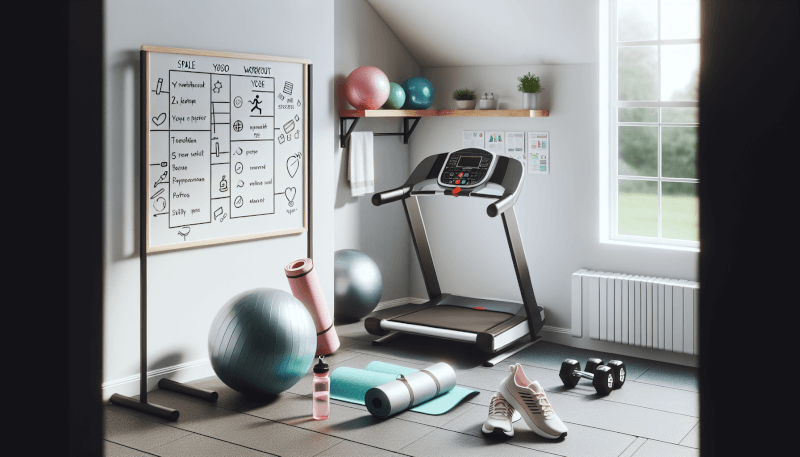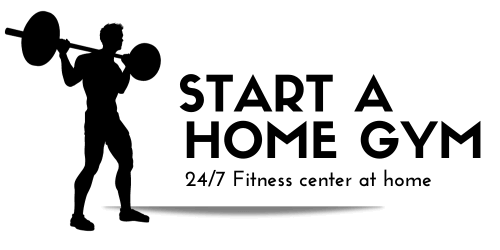Creating an effective workout plan for your home gym can seem like a daunting task, but fear not – we’ve got you covered! In this article, we will guide you through seven simple steps that will help you create a personalized and efficient workout plan that suits your goals and fits perfectly into your home gym routine. Whether you’re a seasoned fitness enthusiast or just starting out, these steps will ensure that you make the most out of your home gym and achieve the results you desire. So let’s get started on building your dream workout plan!

Step 1: Set Your Goals
Creating a workout plan for your home gym begins with setting clear and specific fitness goals. Take some time to think about what you want to achieve through your workouts. Whether it’s losing weight, building muscle, improving endurance, or simply staying active, defining your fitness goals will help you stay focused and motivated throughout your workout journey.
Consider your available time when setting your goals. Analyze how much time you can realistically dedicate to your home workouts. Are you a busy professional with limited free time? Or do you have more flexibility in your schedule? Understanding your time constraints will help you determine the duration and frequency of your workout sessions.
Determining your workout frequency is another crucial aspect of setting your goals. How many days per week do you plan to work out? This will depend on your fitness level, availability, and overall health. It’s important to strike a balance between challenging yourself and allowing enough time for rest and recovery.
Step 2: Assess Your Space and Budget
Before you dive into purchasing equipment for your home gym, it’s essential to assess your available space. Take a look at the area you have designated for your workouts and determine how much room you have. Consider the layout, the ceiling height, and any potential obstructions. This evaluation will help you choose equipment that fits your space and allows for comfortable movement during your workouts.
Budget is another significant factor to consider when creating your home gym workout plan. Determine how much you’re willing to spend on equipment. Remember that you don’t need to break the bank to have an effective workout space at home. There are plenty of affordable options available, and you can always start with the basics and gradually expand your equipment collection over time.

Step 3: Choose Your Equipment
Now that you have a clear understanding of your goals, available space, and budget, it’s time to choose the right equipment for your home gym. Consider your fitness goals when selecting equipment. For example, if your goal is to increase strength, you may want to invest in dumbbells, resistance bands, or a weight bench. If cardiovascular fitness is your main focus, consider getting a treadmill, stationary bike, or skipping rope.
When choosing equipment, opt for versatile and functional pieces that can be used for a variety of exercises. This will allow you to maximize your workouts and target different muscle groups. Additionally, prioritize quality and durability when making your equipment selections. Investing in high-quality items will ensure their longevity and safety during your workouts.
Step 4: Design Your Workout Routine
After you’ve acquired the necessary equipment, it’s time to design your workout routine. Start with a proper warm-up and cool-down. A warm-up helps prepare your body for exercise by gradually increasing your heart rate and loosening up your muscles. Incorporate dynamic stretches and light cardio exercises, such as jogging in place or jumping jacks. Similarly, cool down with static stretches to help prevent muscle stiffness and promote recovery.
Select the right exercises based on your goals and equipment. For example, if you have dumbbells, you can incorporate exercises like bicep curls, squats, lunges, and shoulder presses. Aim for a combination of strength, cardiovascular, and full-body exercises to ensure a well-rounded routine. It’s also important to consider your fitness level and gradually increase the intensity and difficulty of your exercises as you progress.
Determine the number of reps, sets, and rest intervals for each exercise. This will depend on your goals, fitness level, and equipment. Beginners may start with 2-3 sets of 10-12 reps for strength exercises, while those more experienced may opt for higher intensity with heavier weights and fewer reps. Rest periods can vary as well, ranging from 30 seconds to a few minutes between sets.
Create a balanced routine that targets different muscle groups and allows for adequate rest between workouts. Aim to work each major muscle group at least twice a week. For example, you can focus on upper body exercises one day and lower body exercises on another day. It’s important to listen to your body and avoid overtraining by giving yourself enough time to recover between workouts.

Step 5: Incorporate Strength and Cardiovascular Training
To create a well-rounded home gym workout plan, it’s important to incorporate both strength and cardiovascular training. Strength training helps build muscle and increase overall strength, while cardiovascular exercises improve cardiovascular fitness, burn calories, and boost endurance.
Include compound exercises in your strength training routine. Compound exercises engage multiple muscle groups simultaneously, helping you get more out of your workouts. Examples of compound exercises include squats, deadlifts, bench press, and pull-ups. These exercises target several major muscle groups at once, making them efficient and effective for building strength.
Choose cardiovascular activities that you enjoy and that align with your goals. If you prefer low-impact exercises, consider using a stationary bike or elliptical machine. For high-intensity workouts, you can incorporate interval training using equipment like a treadmill or rowing machine. Alternatively, if you enjoy outdoor activities, you can go for a run, bike ride, or even engage in activities like hiking or swimming.
Step 6: Incorporate Flexibility and Mobility Training
Flexibility and mobility are often overlooked but important aspects of any workout routine. Incorporating stretching exercises into your plan can help improve flexibility, prevent injuries, and enhance overall performance.
Include stretching exercises for all major muscle groups in your routine. Aim to hold each stretch for 20-30 seconds without bouncing. Examples of stretching exercises include toe touches, standing quad stretches, and shoulder stretches.
Foam rolling is another effective technique to improve mobility and reduce muscle tightness. Incorporate foam rolling into your workout routine by targeting areas that feel particularly tight or sore. Rolling your muscles over a foam roller can help release tension and improve range of motion.
In addition to stretching and foam rolling, consider incorporating mobility drills into your routine. Mobility drills involve moving your joints through their full range of motion to improve overall mobility and joint health. Examples of mobility drills include hip circles, shoulder dislocations, and ankle rotations.

Step 7: Evaluate and Modify Your Plan
Once you have implemented your home gym workout plan, it’s important to regularly evaluate and modify it as needed. This will ensure that your workouts continue to challenge you and help you progress towards your goals.
Track your progress by keeping a workout journal or using a fitness app. Note down the exercises, weights, sets, and reps you perform during each workout. This will allow you to monitor your progress over time and identify areas for improvement.
Adapt your plan to your progression. As you become stronger and more fit, you may need to increase the intensity, weight, or duration of your exercises. Gradually challenging yourself will prevent plateauing and help you continue making progress.
Modify your plan as needed based on your goals, preferences, and any changes in your fitness level. Don’t be afraid to switch up exercises, try new equipment, or incorporate different training techniques. This will keep your workouts interesting and prevent boredom.
By following these 7 steps, you’ll be well on your way to creating an effective home gym workout plan. Remember to set clear goals, consider your space and budget, choose the right equipment, design a balanced routine, incorporate strength and cardiovascular training, incorporate flexibility and mobility training, and regularly evaluate and modify your plan. With dedication and consistency, your home gym workouts will help you achieve your fitness goals and maintain a healthy lifestyle.


